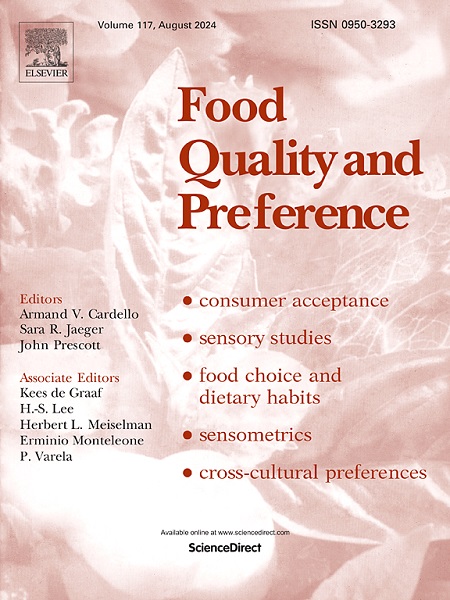南非城市居民对豇豆的熟悉程度各不相同
IF 4.9
1区 农林科学
Q1 FOOD SCIENCE & TECHNOLOGY
引用次数: 0
摘要
本研究考察了影响南非18-46岁城市受访者(N = 931)采用豇豆的认知(知识和信念)和情感(情绪)属性。根据对豇豆的熟悉程度确定了三组受访者:不熟悉(13%),非用户(36%)和用户(51%)。测量了受访者对豇豆的总体感知形象(GPI)、情感、营养知识、信仰、喜欢程度和在饮食中加入豇豆的可能性(采用意向)。在观看了一段强调豇豆营养和健康益处的视频、准备技巧以及用豇豆制作的创新烹饪产品的风格照片后,受访者的GPI、情绪、喜好以及将豇豆纳入饮食的可能性再次被测量。三个熟悉组在GPI、情感、营养知识、信念、喜欢和收养意愿方面存在显著差异。受访者不太了解豇豆的营养特性。与不使用和不熟悉豇豆的人群相比,用户对豇豆的积极营养知识和信念陈述的认同程度更高。在视频干预后,所有组的GPI、情绪、喜欢和采用意愿的平均评分都较高,但对非用户的影响最为深远。该研究提供了南非城市市场豇豆形象的横截面视图。该研究揭示了影响豇豆形象形成的属性,表明信息传播和展示创新的烹饪产品可以增强豇豆的正面形象,并有可能增加其使用和消费。本文章由计算机程序翻译,如有差异,请以英文原文为准。
The image of cowpeas among urban South Africans who vary in familiarity with the product
This study examined cognitive (knowledge and beliefs) and affective (emotions) attributes influencing the adoption of cowpeas among urban respondents (N = 931) aged 18–46 years in South Africa. Three groups of respondents based on familiarity with cowpeas were identified: unfamiliar (13 %), non-users (36 %), and users (51 %). Respondents' general perceived image (GPI) of cowpeas, emotions, nutrition knowledge, beliefs, liking and likelihood to include cowpeas (adoption intention) in their diet were measured. After exposure to a video highlighting cowpea nutritional and health benefits, preparation tips, and styled photographs of innovative culinary products made using cowpeas, respondents' GPI, emotions, liking, and the likelihood of including them in their diet were measured again. There was a significant difference in GPI, emotions, nutrition knowledge, beliefs, liking and adoption intention among the three familiarity groups. Respondents were not very informed about the nutritional properties of cowpeas. Users agreed more strongly with positive nutrition knowledge and belief statements about cowpeas than the non-users and unfamiliar groups. The mean ratings for GPI, emotions, liking and adoption intention were higher for all groups after the video intervention, but the effect was most profound for the non-users. The study provides a cross-sectional view of the image of cowpeas in the South African urban market. It provides insights into the attributes affecting cowpea image formation and indicates that information dissemination and showcasing innovative culinary products can enhance the positive image of cowpea and potentially increase its use and consumption.
求助全文
通过发布文献求助,成功后即可免费获取论文全文。
去求助
来源期刊

Food Quality and Preference
工程技术-食品科技
CiteScore
10.40
自引率
15.10%
发文量
263
审稿时长
38 days
期刊介绍:
Food Quality and Preference is a journal devoted to sensory, consumer and behavioural research in food and non-food products. It publishes original research, critical reviews, and short communications in sensory and consumer science, and sensometrics. In addition, the journal publishes special invited issues on important timely topics and from relevant conferences. These are aimed at bridging the gap between research and application, bringing together authors and readers in consumer and market research, sensory science, sensometrics and sensory evaluation, nutrition and food choice, as well as food research, product development and sensory quality assurance. Submissions to Food Quality and Preference are limited to papers that include some form of human measurement; papers that are limited to physical/chemical measures or the routine application of sensory, consumer or econometric analysis will not be considered unless they specifically make a novel scientific contribution in line with the journal''s coverage as outlined below.
 求助内容:
求助内容: 应助结果提醒方式:
应助结果提醒方式:


